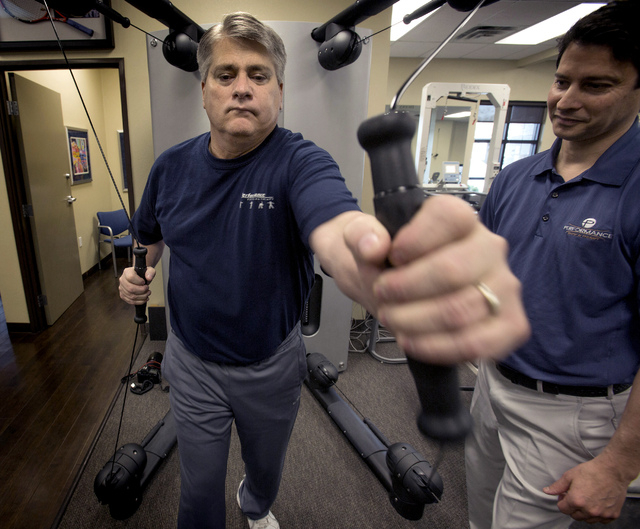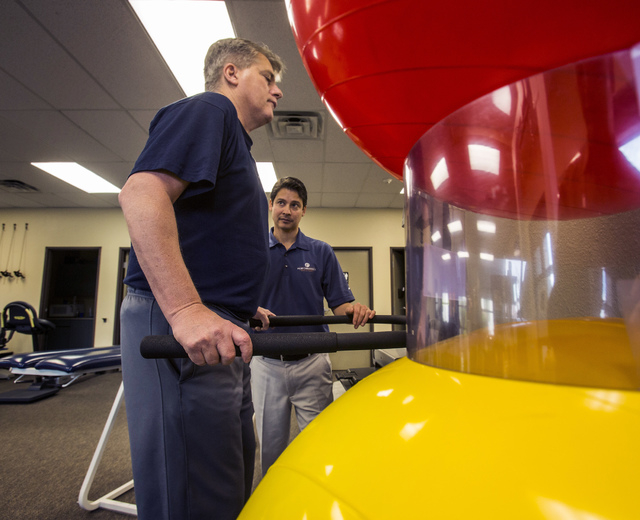Dentist’s accident proves danger of “sleep driving” side effect
Las Vegas dentist Lee Turner knows it happened — that he drove his Ford Escape into a light pole just more than a year ago.
He has citations from the Las Vegas police and scars from multiple operations to prove it.
Turner, 51, also knows he wouldn’t be alive today if it wasn’t for the medical care he received for more than a month from trauma surgeon Terry Lewis and his team at University Medical Center.
That’s why he’s offering free massages to UMC trauma personnel at the hospital this holiday season.
He still struggles to explain, however, how he came to be driving eastbound on Cheyenne Avenue near Rainbow Boulevard shortly after midnight on Nov. 20, 2012.
He said during the early evening of Nov. 19 he had two glasses of wine — “no more than that” — and, because he’d been having trouble getting to sleep, he took an Ambien sleeping pill just before going to bed around 10 p.m.
“I don’t remember anything about that night after I took the sleeping pill,” he said, a sense of disbelief in his voice. “I don’t remember getting up, getting dressed or driving. When I came out of my coma in the hospital, I learned I had been in an accident.”
That knowledge terrified him, he said, until he was reassured that he hadn’t hit someone with his sport utility vehicle.
Turner, whose injuries included a lacerated liver and broken back, continues his painful rehabilitation under the direction of Dan Antonino, a physical therapist at Performance Physical Therapy on West Sahara Avenue.
Based on what he’s learned about Ambien since his accident, Turner said he also wants to deliver a message: Be very careful before taking Ambien, which is linked to a number of oddball side effects, including “sleep driving.”
Ambien, approved by the Food and Drug Administration for short-term treatment of insomnia in 1992, has been used by millions of Americans to help them sleep. Four years after it was rolled out, the drug became the country’s best-selling sleep aid, earning billions for French drugmaker Sanofi. In 2007, zolpidem, the generic version of Ambien, was introduced and is one of the country’s most prescribed medications — 39 million prescriptions were filled for the drug in 2011 alone.
“It does strange things to some people,” said Turner, who has pleaded not guilty to misdemeanor charges of driving under the influence, failure to maintain his lane and driving without a seat belt. A pretrial hearing has been set for Dec. 17 in Las Vegas Municipal Court.
Under Nevada’s DUI laws, driving under the influence doesn’t apply only to drunken driving or driving while under the influence of illegal drugs. You can be charged with DUI even if you have a prescription for the medication.
Turner said that if he should be convicted of DUI, he can handle it. A conviction could mean as much as six months in jail and the Nevada State Board of Dental Examiners could suspend his license.
“Nobody forced that Ambien down my throat,” he said. “I took it. … Of course, I never dreamed I’d go driving because of it. … Listen, if people can learn from me, I’ll be happy. I don’t want anybody else’s family to go through what we’ve been through.”
The possible strange effects of Ambien drew national attention in 2006 after then Rep. Patrick Kennedy, D-R.I., blamed the drug for his 2 a.m. crash into a Capitol Hill barrier. The son of U.S. Sen. Ted Kennedy, D-Mass., was disoriented and told stunned officers on the scene he was late for a vote.
Later, Patrick Kennedy pleaded guilty to driving under the influence and was sentenced to a year’s probation.
Before news coverage of Kennedy’s episode subsided, the drug stayed in the headlines. A class action lawsuit brought on behalf of Ambien users against the drug’s manufacturer charged that the sleeping pill caused them to sleep-eat items that included buttered cigarettes and raw eggs, including the shells.
In 2007, after complaints from sleeping pill users and studies that showed sleep medications with the active ingredient zolpidem caused individuals to engage in behaviors that they would later not recall — including sleepwalking, hallucinations, having sex, and, frighteningly, driving while asleep — the FDA mandated that the makers of Ambien and other sleeping pills put warnings about “sleep driving” and other behaviors on the bottle and on the product medication guide.
In announcing those new warnings, Dr. Russell Katz, the FDA’s director for neurology products, singled out driving while asleep as particularly alarming.
“People get up, they take their car keys and they go drive,” he said. “As you might imagine, that might be potentially dangerous to the patient and others as well.”
Katz said drinking alcohol before or after taking sleep medication appeared to increase the chances of sleep driving. Researchers have said sleep driving occurs in a twilight state between sleep and wakefulness. Why some people engage in such behavior is unknown.
Las Vegas neurologist Eric Farbman, like Katz, noted that sleep-driving behavior is rare and pointed out that the effects of drugs can differ from one individual to another. He said none of the patients that he’s put on Ambien have had problems.
That the government has knowingly allowed a drug to stay on the market that has been shown to put badly impaired drivers on the road is “a risk-benefit thing,” Farbman said.
Lawyer Chip Siegel handled a case in Las Vegas that smacks of Turner’s experience. He represented a woman who went with a designated driver to a Christmas party, where she drank alcohol. After she came home, she took her prescribed Ambien and went to sleep.
Two hours later, according to her husband, she walked down the stairs, got in the car and drove off in her pajamas. She didn’t get far, driving into the neighborhood’s mailboxes. She had no recollection of the event.
The woman was initially convicted of misdemeanor DUI. But after Siegel successfully appealed the verdict, she pleaded guilty to the lesser charge of reckless driving.
The FDA’s position on the drug presents a challenge for the legal system in DUI cases involving Ambien, Siegel said. The agency has recognized sleep driving as an involuntary side effect of the drug, while Nevada’s drugged driving law penalizes the voluntary act of driving under the influence.
An involuntary sleep-driving defense for an Ambien user who unknowingly gets behind the wheel can be negated by the voluntary use of alcohol or other drugs along with the sleep medication, Siegel said.
As he did rehabilitation exercises recently, Turner said he believes that the government should have lowered the recommended dosage of the sleep medication years ago.
In January, the FDA announced it was requiring the manufacturers of Ambien and other sleep drugs that contain the active ingredient zolpidem to lower recommended doses. The agency said new data show zolpidem blood levels in some patients may be high enough the morning after use to impair activities that require alertness, including driving.
The recommended dosage of zolpidem for women was lowered from 10 milligrams to 5 mg for immediate-release products and from 12.5 mg to 6.25 mg for extended-release products. For men, the agency recommended that doctors prescribe doses of 5 mg or 10 mg for immediate-release products and 6.25 mg or 12.5 mg for extended-release products.
In explaining the different strengths for men and women, the FDA said women eliminate zolpidem from their bodies more slowly.
Turner said the Ambien he took the night of his accident was the then-suggested dosage of 12.5 mg.
In May, the FDA also warned people who take the extended-release zolpidem at dosages of either 6.25 mg or 12.5 mg shouldn’t drive or engage in other activities that require complete mental alertness the day after taking the drug because zolpidem levels can remain high enough to impair these activities.
In its action on dosages, the FDA did not directly address sleep driving.
After his accident, Turner said, his wife, Amy, discovered that he apparently had used an electric razor and hair dryer before heading out in his SUV.
He said his accident took place not far from an office where he once worked before he sold his practice. At that time in his life, he said, he was deciding what direction he wanted his career to take.
Dr. Terry Lewis, who kept Turner alive, said the dentist is fortunate to still have a future. Turner’s internal bleeding was so intense that Lewis said he had to take him into surgery three times to stop it. Thirty-six units of blood were used to keep him alive.
Weeks passed before Dr. Al Capana could address the fractures in Turner’s back.
Lewis believes that the constant bedside presence of Turner’s family — he has three children — factored in his recovery.
“I have noticed over the years that patients in critical condition pick up on the voice of people they love and it gives them a reason to fight,” Lewis said.
Amy Turner said she and her husband still are awed by how UMC’s trauma unit fights for patients.
“They were amazing,” she said. “I’m afraid far too many of us in Las Vegas take UMC for granted.”
No one can tell today that Turner was near death about a year ago. However, he says damage to his right arm, which keeps him from turning his forearm completely, probably won’t allow him to practice dentistry again. He may teach.
Sleep-driving accidents such as Turner’s have profoundly affected criminal defense attorney Siegel, who researched Ambien extensively before representing his female client on her DUI charge.
“I have told all my family members, if you’re taking Ambien, don’t keep your keys where you normally do. Because that’s one of the first things you’ll do if you wake up in that strange state, reach for where they usually are. Put them someplace where you haven’t put them before.”
Reporter Paul Harasim can be reached at pharasim@reviewjournal.com or 702-387-2908.
























